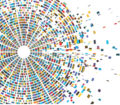Cities around the world are getting one step closer to resembling the futuristic utopia in The Jetsons thanks to the “smart city” trend. By upgrading streetlights, buildings, and traffic signals with software and advanced wireless technology, smart cities are able to tackle the ills of urban growth—congestion, pollution, and aging infrastructure—through big-data analytics.
San Diego is looking to take the smart city concept to the next level, and is rolling out a big expansion of a smart city network next month in a program backed by GE, AT&T, and Intel.
Largest Smart City Yet
3.2K
The number of streetlights that will be outfitted with cameras, microphones and sensors as part of the year-long smart city expansion.
14K
The number of streetlights that will be replaced with wireless and energy-efficient models.
160
Total miles of streets in San Diego’s smart city area, including downtown, East Village, North Park, South Park, Golden Hill, parts of Mission Valley, Allied Gardens, and Encanto.
A Tsunami of Data
The smart city expansion will produce an overwhelming amount of data, and software developers can tap into it to develop apps.
They did just that last year during a hackathon competition at UC San Diego, with data from the smart city pilot in East Village. One resulting app aimed to help residents track water use in real-time and compare with past consumption.
More UCSD hackathons are slated as part of data-sharing efforts.
“We want to unleash the power of our software developers, who can improve civic life,” says David Graham, the city’s deputy chief operating officer.
Big Data or Big Brother?
Last December, the San Diego City Council voted 7-0 to approve the smart city expansion—without talk of privacy.
Christie Hill, senior policy strategist with the ACLU of San Diego and Imperial Counties, says the smart city program needs “strong mechanisms for transparency, accountability, and oversight.”
Tracking people, the city swears, isn’t possible.
“It’s anonymized data,” Graham says. “If we want to improve pedestrian safety, we may receive data saying a human-sized object was 4 feet away from a truck-sized subject. But we wouldn’t know who or what either of these things were.”
Self Funded
$30.3 million
Total cost of smart city program
$2.4 million
Expected annual energy savings due to the new streetlights
13 years
How long it will take for the program to pay for itself
On the Horizon
Chicago just unveiled the “Imagine Project,” a lofty proposal to transform over 100 undeveloped acres in the South Side into a smart city.
In Copenhagen, 380 new sensor-laden streetlights are expected to cut travel times for transit riders by 5 to 20 percent.
Barcelona has sensors for monitoring air quality and noise.
London uses cameras with license-plate recognition technology to monitor cars (and toll drivers) entering the congestion zone in the city center.
Sources: Forbes, City of San Diego, MSN, City of London, Chicago Inno
Tags: Innovation, Next Big Thing, Smart City, Tech






























